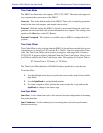
Euphonix SH612 Studio Hub User Guide Integration With Jupiter VM3000 Routers
30
4.2.5 AES/Analog Routing
The SH612 treats all signals as time-division multiplexed (TDM) digital signals, which
means that any level of any input can be routed to any level of any output. It does not
matter if the original was an AES digital or analog signal: The Euphonix input convert-
ers (AM713 for analog, DM714 AES), and their corresponding output converters
(MA703 and MD704) feed MADI signals to the Studio Hub, which routes them without
regard to their original format, source, or destination. Analog sources can be routed to
AES destinations, and AES sources to analog destinations. Thus, separate levels need
not be created for AES and analog signals in the Jupiter input and output sets. We rec-
ommend creating levels named Audio 1 through Audio 4 (or your highest level number).
4.2.6 Finishing the Configuration
The basic steps for router integration are complete. You may need to create control pan-
el input and output sets or modify your currently existing control panel sets to accom-
modate the inputs and outputs on the SH612. This is the same as creating Jupiter control
panel sets for any other switcher (see the Jupiter Operations Manual for more informa-
tion). When finished, close the Configurator and activate the edited configuration set
on your VM3000 board by selecting JNS Applications->Control Center.
Before proceeding, verify the routing has been properly implemented. Send audio to
some of the SH612’s inputs and perform some routes using a Jupiter control panel or
the Router Control applet in the JNS Applications tab of the JNS Control Console soft-
ware.


















